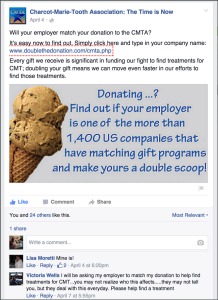I’ve recently signed a contract that has me working with organizations in upstate New York, Vermont and New Hampshire for the next few months. With this new super new exciting challenge, I plan on increasing my use of guest blog posts as a way to make my life work. Hopefully, this will also bring new and exciting points of view to the DonorDreams blog community. I want to thank Gretchen Barry and our friends at NonProfitEasy for today’s contribution. I’ve included Gretchen’s bio at the end of today’s post. Enjoy! ~Erik
4 Ways to Improve Your Direct Mail Strategy
By Gretchen Barry
NonProfitEasy
 The ease of technology now reaches almost all aspects of life, even fundraising. With the help of social media and email and texting, nonprofits are now able to raise money with the click of a button. This shift has been hugely beneficial.
The ease of technology now reaches almost all aspects of life, even fundraising. With the help of social media and email and texting, nonprofits are now able to raise money with the click of a button. This shift has been hugely beneficial.
Easy access equals quick donations.
HOWEVER, the growth in online fundraising techniques does not mean that older methods should fall by the wayside. In particular, direct mail should remain a fundraising method of choice.
There’s a common misconception that direct mail is only for reaching nonprofits’ ages 65+ demographic. There is some validity in this statement. Yes, a powerful contingent of donors prefers direct mail because those in that age range use the online functionalities nonprofits provide with less frequency.
Remember though, younger donors appreciate direct mail just as much.
For young donors, like millennials, snail mail is actually a novelty. The internet has made everything so easy that it takes very little effort to email a friend or send an e-card.
A hand-written note or a personalized, mailed package takes effort and, as a result, shows dedication and care. A direct mail campaign will surprise and connect with the elusive and generous millennial population.
Showing care in your communications is a great way to improve your fundraising effectiveness. Direct mail can make a huge difference in your donor acquisition efforts. People want to feel appreciated for the time and money they’ve invested in your cause.
The four tips below will help ensure your team is implementing the best direct mail strategy around.
1) DECIDE IF THE FUNDRAISER IS RIGHT FOR DIRECT MAIL
This point might seem obvious, but let me explain. Each nonprofit is centered on a mission to serve a needed and worthwhile cause.
It should be easy to convince people that your cause is worth caring about. What’s harder, and what should come into play when deciding whether to use direct mail or not, is knowing if any given fundraising campaign will be one people will feel compelled to donate towards.
Campaigns run the gamut. Some are for new equipment. Others are for events. The scope is broad, but usually you’re asking for funds for a set venture rather than a generic fund.
So you can feel confident about your decision to put the extra effort and money into direct mail fundraisings, ask:
Once you’ve thought through those questions, you’ll be better equipped to decide if direct mail is the right fit.
Direct mail is not limited to fundraising. Its uses range from sending out educational content to requesting RSVPs for an event. Don’t forget that when weighing if direct mail is the right fit.
Just really think through what you’re asking for. A donor wants to help the cause. She might be more inclined to donate an auction item to your annual gala’s live auction than a check for new office chairs. Both asks are valid, but you have to determine what is important to your constituents.
2) KEEP AN EXCELLENT MAILING LIST
An ineffective mailing list will result in an ineffective campaign.
There are three biggies when it comes to organizing a mailing list:
- Reliable Donors
- Updated Information
- High-Quality Prospects
You want to spend your time and money contacting those who read and respond to direct mail. It’s a good idea to have a donor segment of your prospects and donors who prefer direct mail.
If a donor has a history of never contributing as a result of a hand-mailed campaign, why would you spend the postage on shipping materials to him?
Also think about the time wasted mailing an item to a donor’s former address, or, worse, referring to an outdated detail.
Let’s say Mrs. Smith, formerly Ms. Jones, has moved in with her new husband. If your list doesn’t have this information, your campaign likely won’t reach her. If you do end up getting the correct address, what happens when she’s addressed by her maiden name?
Side-step this problem by making sure your donor database information is current and accurate.
The mishap might not upset her, but using her new, married name would certainly impress her. It would demonstrate care — one of the biggest benefits of direct mail.
3) ATTACH A SELF-ADDRESSED STAMPED ENVELOPE (SASE)
If direct mail’s benefit is a demonstration of effort and email’s benefit is ease, how do you bridge that gap? Just because donors enjoy the care you put into sending a package, it doesn’t mean that they won’t miss the simplicity of donating online.
How do we solve this problem? Send your mailings with an SASE. If your donor has decided to send funds don’t lose them on a technicality. Take the guess work out of replying.
With a SASE a donor simply applies postage and sticks the envelope in the mail. You could even talk to your post office about getting a permit to make the postage on your SASEs pre-paid.
4) TRACK YOUR RESULTS
Your direct mail methods should become more effective over time if you actively work on improvement. What’s the best way to improve your approach? You look at what you’re doing, determine areas of weakness, and focus on lessening those weaknesses.
Take advantage of your experiences by tracking campaign results. That data will provide invaluable insight into potential direct mail mistakes.
Here’s what you should be analyzing:
- Number of responses
- Response type — How many RSVPs? How many no thank yous?
- Donation amounts (if applicable)
- Number of returns to sender
- Comparison of funds raised versus costs to send
After a campaign, you will have the raw data. That raw information will be the foundation of the metrics listed above. Let that data make a difference.
With the way recent technology has revolutionized the nonprofit marketplace, it is difficult to resist the urge to go completely digital. Don’t forget about direct mail though. If you do, you’ll be missing out on an incredibly valuable opportunity.
 Gretchen Barry, Director of Marketing — Gretchen has been a leader in corporate communications and marketing for 20+ years. Gretchen has published numerous articles related to charitable giving and is a passionate advocate for public schools. Gretchen has donated her time to numerous causes including Relay for Life, Girls on the Run, Rebuilding Together, and just recently became involved with the local land trust. Gretchen graduated from the University of Nevada with a degree in English literature.
Gretchen Barry, Director of Marketing — Gretchen has been a leader in corporate communications and marketing for 20+ years. Gretchen has published numerous articles related to charitable giving and is a passionate advocate for public schools. Gretchen has donated her time to numerous causes including Relay for Life, Girls on the Run, Rebuilding Together, and just recently became involved with the local land trust. Gretchen graduated from the University of Nevada with a degree in English literature.
 I came across a cool infographic from DonorSearch thanks to Bloomerang’s Monthly Nonprofit Wrap-up digest of blogs and fundraising resources. After digesting the data in the infographic, I couldn’t help but conjure up an image of Yoda talking to a fundraising professional and saying “Use your donor database you shall.” Hahaha! OK, maybe this thought was a result of Force Friday and all the marketing hype around the soon-to-be-released newest Star Wars movie. Regardless, please keep reading . . .
I came across a cool infographic from DonorSearch thanks to Bloomerang’s Monthly Nonprofit Wrap-up digest of blogs and fundraising resources. After digesting the data in the infographic, I couldn’t help but conjure up an image of Yoda talking to a fundraising professional and saying “Use your donor database you shall.” Hahaha! OK, maybe this thought was a result of Force Friday and all the marketing hype around the soon-to-be-released newest Star Wars movie. Regardless, please keep reading . . .
 With so many people posting updates, Tweeting the latest news, and hashtagging photos of their lunch, it’s a good idea to jump on the social media bandwagon and utilize different sites to promote matching gifts programs.
With so many people posting updates, Tweeting the latest news, and hashtagging photos of their lunch, it’s a good idea to jump on the social media bandwagon and utilize different sites to promote matching gifts programs.  Slavery ended on December 6, 1865 when the 13th Amendment to the Constitution of the United States was ratified. In a nutshell, this means that people cannot own people anymore. I have a hard time juxtaposing this fact with what I hear some non-profit professionals sometimes say, which is: “. . . that is my donor“.
Slavery ended on December 6, 1865 when the 13th Amendment to the Constitution of the United States was ratified. In a nutshell, this means that people cannot own people anymore. I have a hard time juxtaposing this fact with what I hear some non-profit professionals sometimes say, which is: “. . . that is my donor“. Let’s face it . . . non-profit organizations typically have many competing priorities and projects usually going on simultaneously (e.g. supporting the annual fund, building a new building, renovating an existing space, endowing a program, etc).
Let’s face it . . . non-profit organizations typically have many competing priorities and projects usually going on simultaneously (e.g. supporting the annual fund, building a new building, renovating an existing space, endowing a program, etc).
 The people closest to your mission are board and staff members. So, when the organization is short on cash and cannot meet its payroll obligations, it is only natural to ask board members to dig a little deeper.
The people closest to your mission are board and staff members. So, when the organization is short on cash and cannot meet its payroll obligations, it is only natural to ask board members to dig a little deeper. Don’t pass the basket and ask smaller, low capacity donors. Identify your larger, more capable donors and schedule an in-person meeting to explain what has occurred and ask for their support.
Don’t pass the basket and ask smaller, low capacity donors. Identify your larger, more capable donors and schedule an in-person meeting to explain what has occurred and ask for their support. Accounts receivable can be any number of the following individuals/entities:
Accounts receivable can be any number of the following individuals/entities: If your organization finds itself in this mess, then the bank is probably not extending you additional credit. While managing your cash flow on the backs of your vendors is a bad thing to do, sometimes life presents you with a bunch of bad options.
If your organization finds itself in this mess, then the bank is probably not extending you additional credit. While managing your cash flow on the backs of your vendors is a bad thing to do, sometimes life presents you with a bunch of bad options. This crisis came to your door for a reason, and you owe it to your clients, donors, volunteers and community to make sure it doesn’t happen again. The following is an incomplete checklist of things you should consider:
This crisis came to your door for a reason, and you owe it to your clients, donors, volunteers and community to make sure it doesn’t happen again. The following is an incomplete checklist of things you should consider: For those who are curious, here are those 12 steps to a simple and effective face-to-face solicitation:
For those who are curious, here are those 12 steps to a simple and effective face-to-face solicitation: This morning’s video also reminded me of another YouTube video a friend sent me a few days ago. It is a montage of video clips featuring actor Matt Damon in the HBO television series “Entourage“. The YouTube video illustrates the emotions, fears, and mistakes associated with asking your friends and colleagues for a charitable contribution.
This morning’s video also reminded me of another YouTube video a friend sent me a few days ago. It is a montage of video clips featuring actor Matt Damon in the HBO television series “Entourage“. The YouTube video illustrates the emotions, fears, and mistakes associated with asking your friends and colleagues for a charitable contribution.![IMG_20150802_102350339_HDR[1]](https://donordreams.files.wordpress.com/2015/08/img_20150802_102350339_hdr1.jpg?w=300) A few days ago, I was in an airport trying to catch a connecting flight when I saw a poster advertisement for an international non-governmental organization (NGO) that provides medical services to children and families in third world countries. I took a picture of the portion of the advertisement that immediately caught my attention.
A few days ago, I was in an airport trying to catch a connecting flight when I saw a poster advertisement for an international non-governmental organization (NGO) that provides medical services to children and families in third world countries. I took a picture of the portion of the advertisement that immediately caught my attention. One of the clients I’ve been working with for a while is located in Bloomington, Indiana, which is where I met Rachael Jones. Rachael is a transgender woman who used to own “Rachael’s Cafe”. Unfortunately, after eight years of serving coffee, food and a side of acceptance, Rachael closed her doors last month. During my last visit, the executive director handed me a copy of the June 29th edition of The Herald-Times newspaper with a front page story headline that read “Downtown gathering place closes after 8 years of fostering acceptance“. He shared the newspaper story with me because he knew I had wanted to be there for Rachael’s last day, but I just couldn’t make it work with my travel schedule.
One of the clients I’ve been working with for a while is located in Bloomington, Indiana, which is where I met Rachael Jones. Rachael is a transgender woman who used to own “Rachael’s Cafe”. Unfortunately, after eight years of serving coffee, food and a side of acceptance, Rachael closed her doors last month. During my last visit, the executive director handed me a copy of the June 29th edition of The Herald-Times newspaper with a front page story headline that read “Downtown gathering place closes after 8 years of fostering acceptance“. He shared the newspaper story with me because he knew I had wanted to be there for Rachael’s last day, but I just couldn’t make it work with my travel schedule. The ease of technology now reaches almost all aspects of life, even fundraising. With the help of social media and email and texting, nonprofits are now able to raise money with the click of a button. This shift has been hugely beneficial.
The ease of technology now reaches almost all aspects of life, even fundraising. With the help of social media and email and texting, nonprofits are now able to raise money with the click of a button. This shift has been hugely beneficial. Gretchen Barry, Director of Marketing — Gretchen has been a leader in corporate communications and marketing for 20+ years. Gretchen has published numerous articles related to charitable giving and is a passionate advocate for public schools. Gretchen has donated her time to numerous causes including Relay for Life, Girls on the Run, Rebuilding Together, and just recently became involved with the local land trust. Gretchen graduated from the University of Nevada with a degree in English literature.
Gretchen Barry, Director of Marketing — Gretchen has been a leader in corporate communications and marketing for 20+ years. Gretchen has published numerous articles related to charitable giving and is a passionate advocate for public schools. Gretchen has donated her time to numerous causes including Relay for Life, Girls on the Run, Rebuilding Together, and just recently became involved with the local land trust. Gretchen graduated from the University of Nevada with a degree in English literature. My neighbor owns and operates a home business, and last week he received a letter from a local non-profit organization asking him to sponsor a
My neighbor owns and operates a home business, and last week he received a letter from a local non-profit organization asking him to sponsor a